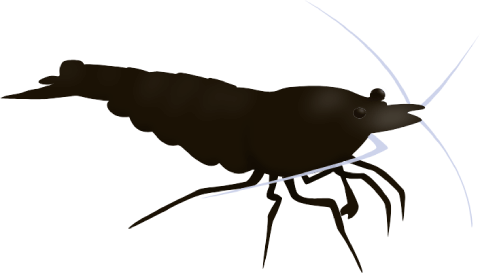Water parameters
- pH
- 6.5 - 8.0
- GH
- 4 - 10
- KH
- 1 - 8
- TDS
- 100 - 180
- Temperature
-
15 - 30 °C
59 - 86 °F
Facts
Difficulty level- Easy
Lifespan- 1 - 2 years
Origin- Taiwan
Adult size- 30 mm / 1.2 inches
The Black Rose shrimp is part of the Neocaridina family of shrimp. Their shells have a strong black colour, slightly darker than the brown Chocolate shrimp. They’re bred by selectively breeding darker and darker variants from the Chocolate morph until reaching almost pure black shells.
An adult will usually grow to a size of 3 cm (1.2 inches).
Grades
High grade Black Roses will have a powerful black colour all over their body and legs. This solid black should extend all the way from their head to their tail consistently, having no lighter or transparent patches.
A lower grade will likely look similar to the Chocolate shrimp, having a colour closer to a dark brown than a deep black. Their legs also will either be mostly translucent or be much lighter than their body.
Female shrimp will normally have much stronger colouring compared to the males, so be careful if you’re culling and breeding higher grades. Ensure you have both male and female shrimp in the tank, despite the fact the males will likely appear to be lower grade.
Care
The Black Rose is one of the easiest to look after, and they will normally live for 1-2 years in a well maintained setup.
Being a hardy species, they can enjoy a good range of water types and parameters. To reduce the risk of any molting issues, it’s important to keep the KH between 1 and 8, and the GH between around 4 to 10.
A heater isn’t necessary for keeping Black Rose warm, as long as the room will stay above 15 °C. However, if you do live somewhere with bitterly cold winters, or your shrimp tank is right by a window, then using a heater can be a good idea.
Freshwater dwarf shrimp should be kept in a minimum tank size of 5 gallons (19 litres), however choosing a larger tank of 10 gallons (38 litres) is preferred as it’s much easier to adjust the water parameters without causing huge parameter swings.
Diet
Freshwater dwarf shrimp of all types eat pretty much the same diet. Biofilm and algae will naturally grow all over the hardscape and keep the shrimp busy grazing all day. In a well established tank, especially one with lots of plants, there will be plenty of natural food already.
Feeding your shrimp common foods like bee pollen, shrimp pellets, algae wafers, blanched vegetables, etc. is also possible if you’re setting up a new tank for example.
Your shrimp will get all the nutrients and minerals they need to grow well and molt safely if you feed them a balanced diet with different food types.
Tank mates
Amano shrimp are a safe choice as a tank mate for Black Rose shrimp. Amanos can grow to be slightly larger, and their lighter colouring will contrast nicely with the darker shrimp. There’s no risk of interbreeding with your Neocaridina, as they’re a different species that also require brackish water for their young.
Find the ideal water parameters and compatible tank mates for Black Rose shrimp.
Any popular aquatic snails will be happy tank mates too, they’ll appreciate the harder water. The hard water will give them all the nutrients necessary for growing a healthy shell.
If you’d like to maintain a strong shell colour in your tank, you’ll want to avoid mixing other Neocaridina in too. Allowing different colour Neos to breed together weakens the strength of both colours and could lead to morphs known as “wild types”.
It’s sometimes possible to keep small fish, such as Neon Tetras, in with your shrimp. There is still some risk that the fish will see your Black Rose shrimp as food, however. To try and prevent this, you should make sure the shrimp have got plenty of hiding places. The risk of being eaten is much higher for baby shrimp, so if you’re wanting to grow your colony, it’s probably a good idea to not have any fish in the same tank.
Breeding
When it comes to breeding Neocaridina shrimp, mixing different colours to create hybrids doesn’t result in what you’d get with Caridina shrimp, for example. Instead, the babies are likely to be a lower grade version of a parent. Wild type shrimp might also appear in the first generation.
With disciplined culling (i.e. moving to another tank) the lighter black coloured shrimp, you can gradually increase the grade in your tank. You will need a lot of patience with this though, you could have a blend of different grades for some time.
There are some tips for breeding shrimp to try, which will hopefully make this process a little quicker.


